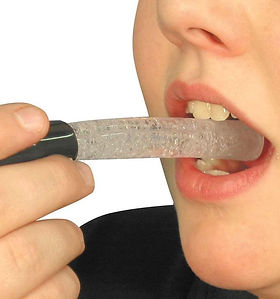
Feeding Therapy Program
For Infants with Poor Suck and Children with Motor Impairment.
Sensory Stimulation Techniques
Sensory stimulation techniques vary and may include
Pic. 1 Thermal stimulation, using ice stick
Feeding Therapy Techniques

-
thermal - tactile stimulation

EVIDENCE HIGHLIGHT
-
Children receiving non-oral feeding may receive an oral sensorimotor program to normalize sensation and promote skill development (NHS, 2008; Taylor-Goh, 2005).
I'm a paragraph. Click here to add your own text and edit me. I’m a great place for you to tell a story and let your users know a little more about you.
thermal stimulation e.g., using iced lemon glycerin swab
tactile stimulation e.g., using a Nuk brush apply to the tongue or around the mouth.
Children who demonstrate aversive responses to stimulation may need approaches that reduce the level of sensory input initially, with incremental increases as the child indicates tolerance. The opportunity for sensory stimulation may be needed for those with reduced responses, over-active responses or limited opportunities for sensory experiences.
EVIDENCE HIGHLIGHT
- The effectiveness of compensatory strategies such as postural changes and maneuvers should be evaluated prior to implementation, and optimal body positioning should be identified (Taylor-Goh, 2005).
Maneuvers Technique
Maneuvers are specific strategies used to change the timing or strength of particular movements of swallowing (Logemann, 2000). Some maneuvers require following multi-step directions and may not be appropriate for young children and/or older children with cognitive impairments. Examples of maneuvers include

Pic. 2 Thermal stimulation, using cold fruit juice
-
Effortful swallow-increases posterior tongue base movement to facilitate bolus clearance.
-
Masako or tongue hold-tongue is held forward between the teeth while swallowing; this is performed without food or liquid in the mouth to prevent coughing or choking.
-
Mendelsohn maneuver-designed to elevate the larynx and open the esophagus during the swallow to prevent food/liquid from falling into the airway.
- Supraglottic swallow-vocal folds are usually closed by voluntarily holding breath before and during swallow in order to protect the airway.
-
Super-supraglottic swallow-effortful breath hold tilts the arytenoid forward which closes the airway entrance before and during the swallow.

Pic. 2 Thermal stimulation, using cold fruit juice
